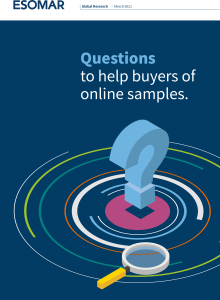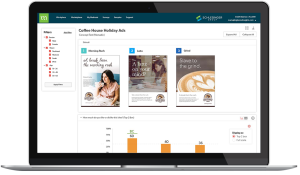Key Takeaways:
- Quantitative research is on the rise, now representing over 70 percent of market research projects.
- There’s been a distinct shift from primarily in-person market research to online methods. As result, fraud has also increased and poses a major challenge to the industry.
- Online market research panels expanded globally, especially as the pandemic shaped the way we reach consumers. This made it easier for marketing teams to reach a wider audience.
Globalization and technology opened up a new world of possibilities for consumers to have their needs met, which requires attention and adaptability from companies and marketers alike. It’s visible throughout the sample industry.
The need for quantitative data answers important questions about your business, such as:
- Is there a market for your product or service?
- If you’re introducing a change to your product or service, will it make a positive impact?
- How are your customers’ buying habits changing?
That said, the way we collect and analyze quant has to change, especially with the impact of the ongoing pandemic. We’ll cover five major trends happening within the global sample industry, so you know how best to extrapolate the highest-quality data about where you and your customers stand in the marketplace.
Trend 1: Increasing Demand for Sample with Less Access to Quality Data
Now more than ever, research teams and nonmarketers alike want better ways to collect global sample to drive their strategies forward. Paired with this increasing demand for sample, however, is a clear lack of quality sources. This means a rise in global sample cost.
Almost 70 percent of research projects in the past used quantitative methods |
According to a Greenbook report, almost 70 percent of research projects in the past used quantitative methods, and that number has increased significantly since the pandemic began. Because respondents are in such high demand, they can afford to be more selective, which drives costs up, too.
Additionally, respondents prefer to take the convenient route when providing information, which means suppliers must adapt to that shift while having to spend more money on targeting traffic and gaining interest. In practice, this means creating concise online surveys and incentivizing them well at the same time. |
Trend 2: Greater Focus on Data Security and Privacy
Stricter privacy and data security policies, implemented across the board, protect both panelists and clients. With privacy now at the forefront of priorities within the market research world, it can be much more difficult to collect third-party data.

However, it helps make people feel more comfortable sharing first-party data, regarding quantitative market research. Having technology in place that properly identifies panelists while keeping experience quality up has been, and will continue to be, a priority for market research firms.
This means putting an emphasis on compliance standards and data transparency with your respondents. For example, data protection laws and regulations require a privacy notice to disclose how the data will be used, disclosed, and managed.
These days, people are less likely to give out their information without clear security measures in place. That said, it’s not enough to simply share your privacy policies; you have to back it up by protecting people’s information.
To continue gathering data from a trustworthy global panel, it’s even more important to choose a sample partner that puts the respondents’ needs first. With advances in technology, it’s easier for hackers to access private information, and this is why we’re continuing to see stricter policies and technology put in place that protect companies and their respondents’ information.
Trend 3: More Fraudulent Activity from Panelists
Along a similar vein of increased privacy policies, companies are minimizing fraudulent activities from respondents by adopting AI and machine learning defense systems to analyze large quantities of data and pinpoint suspicious behaviors.
Fraud spiked 30 percent
|
Over the years, there’s been a distinct shift from primarily in-person market research to online methods. Unfortunately, this has also opened up the door for fraudsters to exercise their craft. Across the industry, fraud spiked 30 percent in 2020, which is believed to be exacerbated by the pandemic. |
Pinpoint the source of fraudulent activity at the entrypoint into your online survey to avoid the many issues that come. That way, you won’t be stuck dealing with it down the line.
A fraudulent participant deliberately misrepresents their identity, profiling information, or responses with the goal of invading market research surveys in the efforts to make money from the incentives. Some common methods they’ll use include:
- Using bots that impersonate participants.
- Paying individuals and training them on how to pass quality control checks for online surveys.
- Stealing identities through data breaches for participants to use.
- Incorporating synthetic fraud, which combines the use of fake and real information.
Not all data is good data, and companies are starting to wake up to this harsh reality. To make the best possible decisions for business growth, it’s important to ensure you are analyzing good data from real respondents in your research panel.
Due to increasing opportunities for fraudulent activities, research marketing teams find it more challenging to find legitimate respondents with additional verification measures. That’s why they put more of an emphasis on technology and compliance in verifying respondents are who they say they are.
Trend 4: Broader Access to Sources for Sampling
Online market research panels expanded globally, especially as the pandemic shapes the way we reach consumers. This made it easier for marketing teams to reach a wider audience through many methods. Some of these include:
- Non-research activities such as watching ads, downloading apps, completing marketing offers, and more.
- Customer lists that collect consumer demographic data such as name, address, phone number, email, and more.
- Affiliate networks that allow the sample provider to direct traffic to their surveys.
- Offer walls that provide respondents with a reward in exchange for their participation.
By blending these methods, you can avoid potential biases you may encounter from a narrow sample coming from one source. That said, it’s important to keep in mind as you collect this data that different methods will produce different results.
Trend 5: Better Direct Access to Sample Sources Through Self-Serve Tools
 Instead of relying solely on sample providers, many market research teams use self-serve tools, such as survey builders, concept tests, and idea-screening software. With this shift, you enjoy more direct access to your sample sources and gain trust, too.
Instead of relying solely on sample providers, many market research teams use self-serve tools, such as survey builders, concept tests, and idea-screening software. With this shift, you enjoy more direct access to your sample sources and gain trust, too.
Furthermore, researchers are moving away from low-tech quant methods like telephone IDIs, computer-assisted phone interviews, and the use of mail. Newer methods, such as online surveys, online panels, and quantitative fieldwork are becoming the norm.
Leveraging Global Sampling Trends for Your Business
When it comes to collective quantitative data from global sample — and navigating the research world in general — you will always deal with shifts in how to collect sample and how to ensure it is truly useful for your business.
With the added impact of the pandemic, these shifts are much more prevalent today, and it is important to understand how to navigate these changes as they occur. While these five trends represent the most important changes happening in the global sample industry, it’s your job to continuously keep up with the ever-shifting nature of market research.




 7 Minutes
7 Minutes 
















